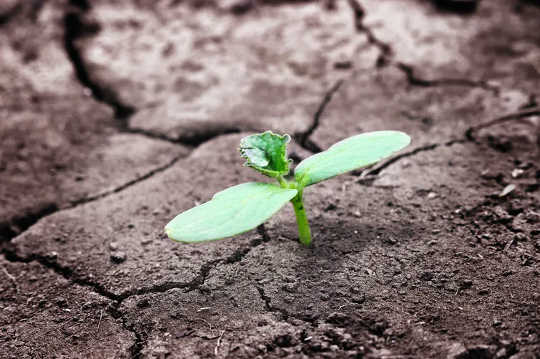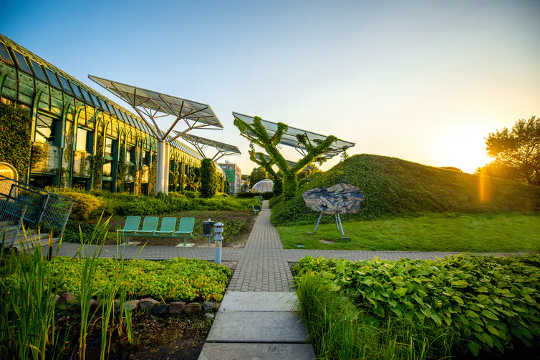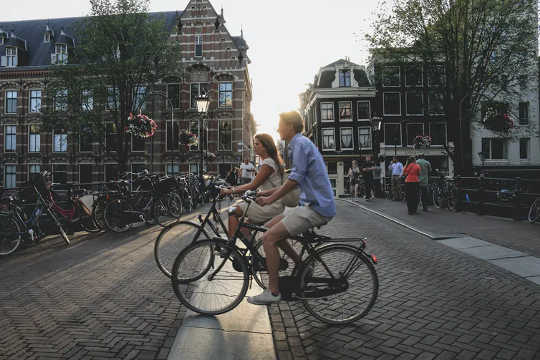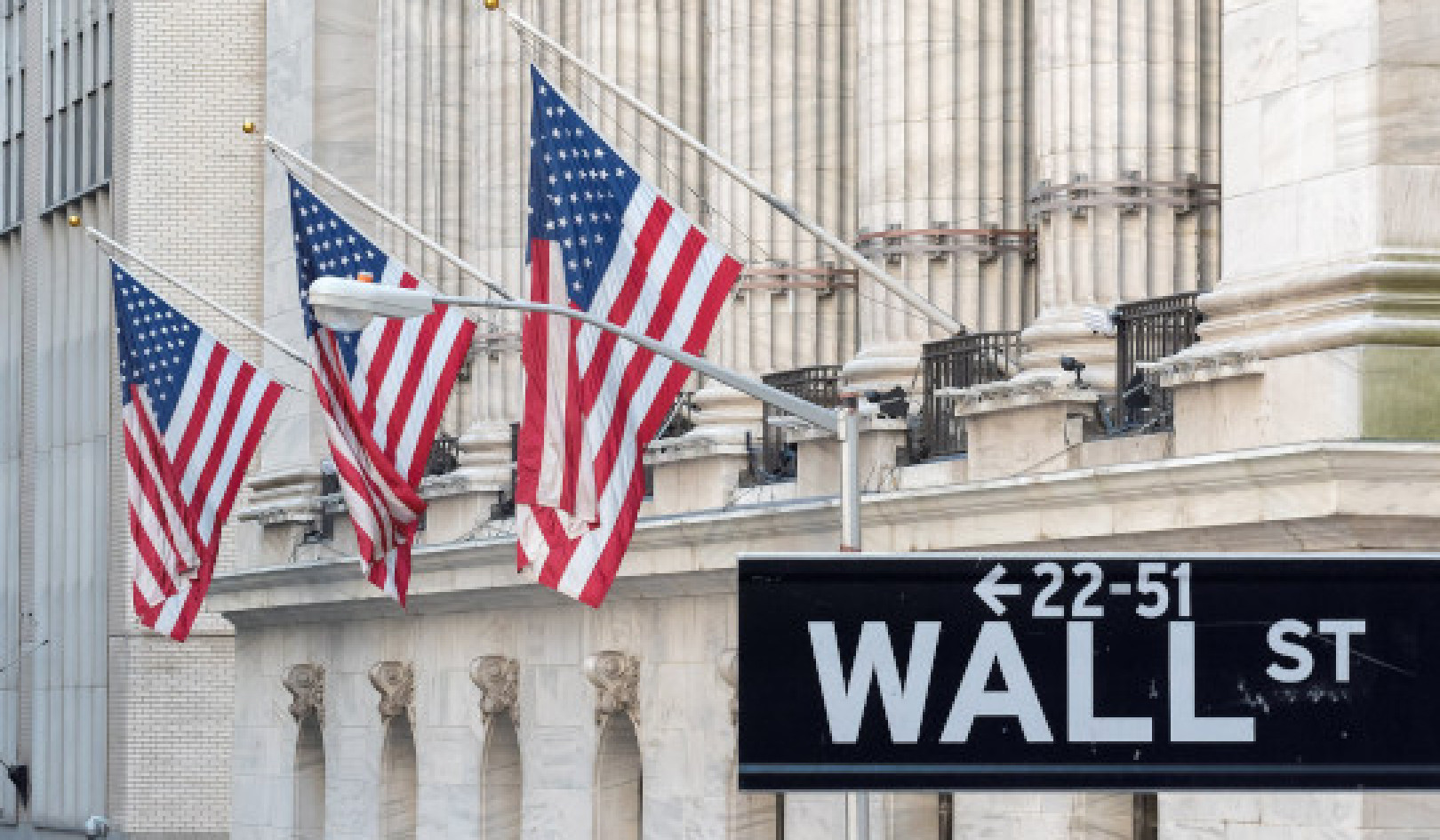
Natalia D / shutterstock
With a recession looming, it’s time to come up with a good recovery plan. There is no point in simply reinventing an outdated economic model, and recent research by economists and health experts has underlined how instead a “green recovery” could benefit not just the climate but also human health and prosperity.
Indeed, many business leaders are already calling for action to reverse nature loss, a strengthened net-zero carbon goal, and a more circular economy. If this sort of mission is to be successful, it will need some quick wins in order to build support and participation among citizens and like-minded investors. So here are five proposals that could kickstart a green recovery from COVID-19:
1. Better buildings
People were in lockdown for weeks and months and are fed up being confined to their homes. A green recovery should start here. That means mass refurbishments to improve insulation, replace windows, reduce air leakage, improve heating (and cooling) systems, and switch fuels from coal, gas and oil towards renewable energies such as wind and solar.
We could make better use of roof space for new housing, solar energy, water storage, gardening and more. There are some issues with these green roofs: risks of air pollutants, increased moisture and emerging biohazards. But doing this well and in time will create many jobs.

How to make use of a roof. RossHelen / shutterstock
2. Better access to healthy food
Food insecurity has been rising, and obesity has been an aggravating factor in COVID-19 mortalities. Healthy diets are proven precautionary measures, supporting immune systems along with improving fitness and robustness.
To encourage people to consume more fruits, vegetables and cereals, the government could consider lowering the VAT rate for organic food and healthy suppliers. To make such food more appealing, it could also set up form of “traffic-light” labelling that displayed the endorsement of NGOs and confirmed good production conditions. Setting up schemes and organisations focused on innovations in supply and combating waste would create jobs and make food supply chains more resistant to any recurrent crises.
3. Smart mobility
There is a risk that transport will simply return to the previous norm of traffic jams and air pollution. If an economic recovery is to be green, it will be essential to maintain flexible working schemes with less commuting, even after most workplaces reopen.
Research by academics at the UK Centre for Research into Energy Demand Solutions suggests that the best bet for reducing carbon footprints is reducing car use and moving towards “smart mobility”. This means carpooling, car sharing and bike sharing programs, and well-developed public transportation.
Now is the time to reclaim our cities from motor cars. Any green recovery should include a vast acceleration of biking infrastructures with interconnected cycle highways, safe locking stations, smart renting schemes, recharging infrastructures for e-bikes and e-scooters, and extended walkways. Smart mobility apps can help people link up different modes of transportation. Cities like Copenhagen and Amsterdam have demonstrated all this is perfectly possible.

Amsterdam shows it can be done. Daniel jakulovic / shutterstock
4. Green our neighbourhoods and cities
Maintaining and improving urban green space should now become a top priority. Initiatives like Nesta’s Rethinking Parks or the Heritage Fund’s Future Parks Accelerator are designed to find ways of managing and funding parks and open spaces across entire towns and cities.
People and businesses could renovate derelict areas and recreate public life, with support from local authorities and a governmental green recovery programme. Doing all this will help adjust development planning by shifting priorities towards longer-term sustainability.
5. More resilient infrastructures
Despite $2.5 trillion a year already being spent on infrastructure projects worldwide, more investment is needed to ensure access to housing, mobility, services and greenspace for all in the new abnormal.
Take water, for instance. A green recovery could be boosted by building a new generation of decentralised water tanks, shared between neighbouring apartment owners. This would be better for the environment as rainwater is preserved and could be used for gardening and cleaning outside the home. Meanwhile so-called “sponge city” initiatives can reduce the risk of urban floods by increasing green spaces, restoring wetlands and using permeable new construction materials to absorb rainwater and delay runoff.
The above actions would complement efforts to transform the energy system away from fossil fuels and towards a system based on renewable generation, with decentralised “micro grids” and the ability to cope with a surge in demand from electric vehicles.![]()
About the Author
Raimund Bleischwitz, Chair in Sustainable Global Resources, UCL
This article is republished from The Conversation under a Creative Commons license. Read the original article.
Related Books
Climate Adaptation Finance and Investment in California
by Jesse M. Keenan This book serves as a guide for local governments and private enterprises as they navigate the unchartered waters of investing in climate change adaptation and resilience. This book serves not only as a resource guide for identifying potential funding sources but also as a roadmap for asset management and public finance processes. It highlights practical synergies between funding mechanisms, as well as the conflicts that may arise between varying interests and strategies. While the main focus of this work is on the State of California, this book offers broader insights for how states, local governments and private enterprises can take those critical first steps in investing in society’s collective adaptation to climate change. Available On Amazon
This book serves as a guide for local governments and private enterprises as they navigate the unchartered waters of investing in climate change adaptation and resilience. This book serves not only as a resource guide for identifying potential funding sources but also as a roadmap for asset management and public finance processes. It highlights practical synergies between funding mechanisms, as well as the conflicts that may arise between varying interests and strategies. While the main focus of this work is on the State of California, this book offers broader insights for how states, local governments and private enterprises can take those critical first steps in investing in society’s collective adaptation to climate change. Available On Amazon
Nature-Based Solutions to Climate Change Adaptation in Urban Areas: Linkages between Science, Policy and Practice
by Nadja Kabisch, Horst Korn, Jutta Stadler, Aletta Bonn This open access book brings together research findings and experiences from science, policy and practice to highlight and debate the importance of nature-based solutions to climate change adaptation in urban areas. Emphasis is given to the potential of nature-based approaches to create multiple-benefits for society.
This open access book brings together research findings and experiences from science, policy and practice to highlight and debate the importance of nature-based solutions to climate change adaptation in urban areas. Emphasis is given to the potential of nature-based approaches to create multiple-benefits for society.
The expert contributions present recommendations for creating synergies between ongoing policy processes, scientific programmes and practical implementation of climate change and nature conservation measures in global urban areas. Available On Amazon
A Critical Approach to Climate Change Adaptation: Discourses, Policies and Practices
by Silja Klepp, Libertad Chavez-Rodriguez This edited volume brings together critical research on climate change adaptation discourses, policies, and practices from a multi-disciplinary perspective. Drawing on examples from countries including Colombia, Mexico, Canada, Germany, Russia, Tanzania, Indonesia, and the Pacific Islands, the chapters describe how adaptation measures are interpreted, transformed, and implemented at grassroots level and how these measures are changing or interfering with power relations, legal pluralismm and local (ecological) knowledge. As a whole, the book challenges established perspectives of climate change adaptation by taking into account issues of cultural diversity, environmental justicem and human rights, as well as feminist or intersectional approaches. This innovative approach allows for analyses of the new configurations of knowledge and power that are evolving in the name of climate change adaptation. Available On Amazon
This edited volume brings together critical research on climate change adaptation discourses, policies, and practices from a multi-disciplinary perspective. Drawing on examples from countries including Colombia, Mexico, Canada, Germany, Russia, Tanzania, Indonesia, and the Pacific Islands, the chapters describe how adaptation measures are interpreted, transformed, and implemented at grassroots level and how these measures are changing or interfering with power relations, legal pluralismm and local (ecological) knowledge. As a whole, the book challenges established perspectives of climate change adaptation by taking into account issues of cultural diversity, environmental justicem and human rights, as well as feminist or intersectional approaches. This innovative approach allows for analyses of the new configurations of knowledge and power that are evolving in the name of climate change adaptation. Available On Amazon
From The Publisher:
Purchases on Amazon go to defray the cost of bringing you InnerSelf.comelf.com, MightyNatural.com, and ClimateImpactNews.com at no cost and without advertisers that track your browsing habits. Even if you click on a link but don't buy these selected products, anything else you buy in that same visit on Amazon pays us a small commission. There is no additional cost to you, so please contribute to the effort. You can also use this link to use to Amazon at any time so you can help support our efforts.
























